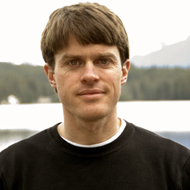UAS-led study on glacial effect on marine environment featured in "Nature" journal
Ancient carbon, Modern food: Glacier melt adds ancient edibles to marine buffet
Juneau, AK
Date of Press Release: January 15, 2010

Glaciers along the Gulf of Alaska are enriching stream and near shore marine ecosystems from a surprising source – ancient carbon contained in glacial runoff, researchers from four universities and the U.S. Forest Service report in the December 24, 2009 issue of the journal Nature, the international weekly journal of science. The study, led by UAS Environmental Science and Geography faculty Eran Hood, highlights previously unrecognized impacts from melting glaciers and provides a new understanding of how glacial runoff can contribute to the ocean food web.
The article, "Glaciers as a source of ancient and labile organic matter to the marine environment," was authored by Eran Hood of the University of Alaska Southeast; University of Alaska Fairbanks Ph.D. student Jason Fellman; Robert G.M. Spencer and Peter J. Hernes of the Department of Land, Air and Water Resources at the University of California Davis; Rick Edwards and David D’Amore of the Pacific Northwest Research Station of the U.S.D.A. Forest Service in Juneau, and Durelle Scott of Virginia Tech.
The research is supported by a three-year grant from National Science Foundation to study the impact of Alaska's melting glaciers on the transport and fate of nutrients in coastal watersheds in the Gulf of Alaska.
Hood and team found that organic carbon released from coastal glaciers is surprisingly valuable as a source of food to coastal food webs despite being thousands of years old. The release of significant amounts of high quality organic carbon to the coastal ocean may be important in supporting ecological productivity and influencing the chemistry along the Alaskan coastline.
In spring 2008, Hood, an associate professor of hydrology, set out to measure the nutrients that reach the gulf from five glaciated watersheds he can drive to from his Juneau office. “We don’t currently have much information about how runoff from glaciers may be contributing to productivity in downstream marine ecosystems,” said Hood. “This is a particularly critical question given the rate at which glaciers along the Gulf of Alaska are thinning and receding.”
Former graduate school colleague Durelle Scott, now an assistant professor of biological systems engineering at Virginia Tech, analyzed the organic matter and nutrient (nitrogen and phosphorus) loads being exported from the Juneau-area study watersheds. "Because there are few reports of nutrient yields from glacial watersheds, Eran and I decided to compare the results from a non-glacial watershed with those of a watershed partially covered by a glacier and a watershed fully covered by a glacier," said Scott.
Hood and Scott’s initial findings, reported in the September 2008 issue of the journal Nature Geoscience, presented something of a mystery. As might be expected, there is more organic matter from a forested watershed than from a fully or partially glacier-covered watershed. With soil development, organic matter is transported from the landscape during runoff events. However, there was still a considerable amount of organic carbon exported from the glaciated landscape.
To better understand the nature of organic carbon contained in glacier runoff, Hood's Ph.D. student, Jason Fellman, collected samples from 11 watersheds along the Gulf of Alaska from Juneau to the Kenai Peninsula in the summer of 2008. The samples were analyzed to determine the age, source, and biodegradability of organic matter derived from glacier inputs.
"We found that the more glacier there is in the watershed, the more carbon is bioavailable to marine microorganisms. And the higher the percentage of glacier coverage, the older the organic material is – up to 4,000 years old," said Scott.
Hood and coauthors hypothesize that forests that lived along the Gulf of Alaska between 2,500 to 7,000 years ago have been covered by glaciers, and this organic matter is now coming out. "The organic matter in heavily glaciated watersheds is labile, like sugar. Microorganisms appear to be metabolizing ancient carbon, and as they die and decompose, biodegradable dissolved organic carbon is being flushed out with the glacier melt," said Scott.
"Our findings suggest that runoff from glaciers may be a quantitatively important source of bioavailable organic carbon for coastal ecosystems in the Gulf of Alaska. Thus, future changes in glacier extent may impact the food webs in this region that support some of the most productive fisheries in the United States," said Hood.